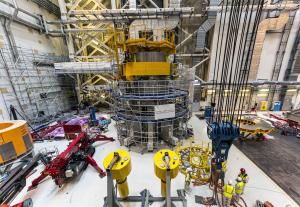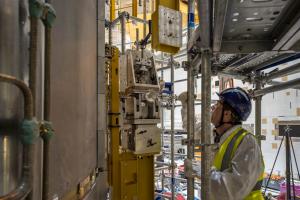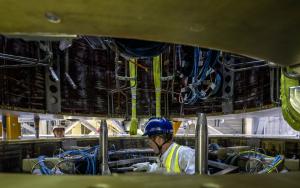The stacking has begun
The central solenoid is one of the most massive components of the ITER machine, as tall as a seven-storey building and weighing in excess of 1,000 tonnes. Made of six 110-tonne cylindrical modules stacked one on top of another and connected by a delicate network of cables and piping, this monster magnet plays an essential role in ITER operation. Its function is to induce and sustain a powerful current (15 MA) inside the plasma. On Tuesday 5 September, the second module of the six-module stack was moved into position on the component's dedicated assembly platform.
Whether in the tokamak assembly pit, in one of the twin sub-assembly tools or in any support or transport structure, the positioning of a component requires both heavy machinery and subtle adjustment devices. This is particularly true of the central solenoid modules: as the approximately 2-metre-tall components are stacked upon one another, any deviation from nominal would be progressively amplified as the stacking progresses. And the tolerance for deviation is low: no more than 20 mm for the 18-metre-tall structure once completed.
Stacking cylindrical devices and connecting their fragile electrical and cryogenics leads demands a particular attention to concentricity and straightness. "We have a target of concentricity between two cylinders of about 0.2 mm and the same for straightness (0.2 mm over 350 mm)," says Carl Cormany, the superconductor engineer responsible for central solenoid assembly. Such precision is achieved through a complex system of adjustment devices whose manual handles allow micrometric movements in pitch, roll and spin.
For operations as strategic as installing ITER components and systems, precision is taken into account long before platforms and tooling are installed. "In terms of precision, nothing is trivial," specifies Cormany. "The formulation of the concrete that anchors the platform plays a part, as does the way bolts are tightened." For a specialist in superconductivity, this is a new domain of expertise.
A third central solenoid module was received at ITER in June and a fourth is expected to ship before the end of the year. In total, US ITER contractor General Atomics is providing seven modules to the ITER Organization, one of them a spare.




